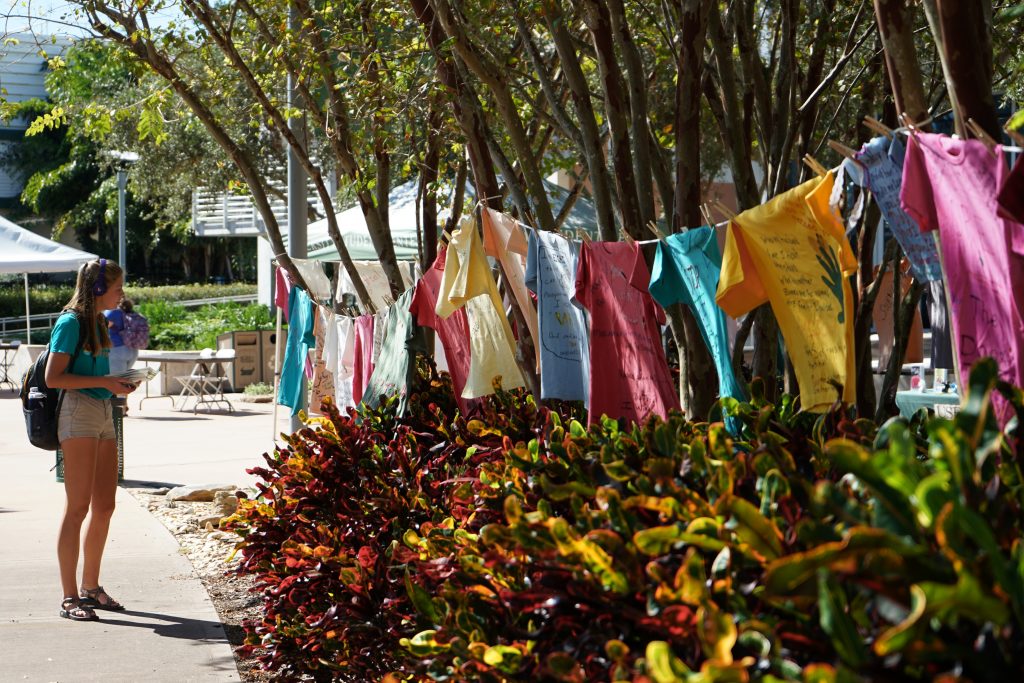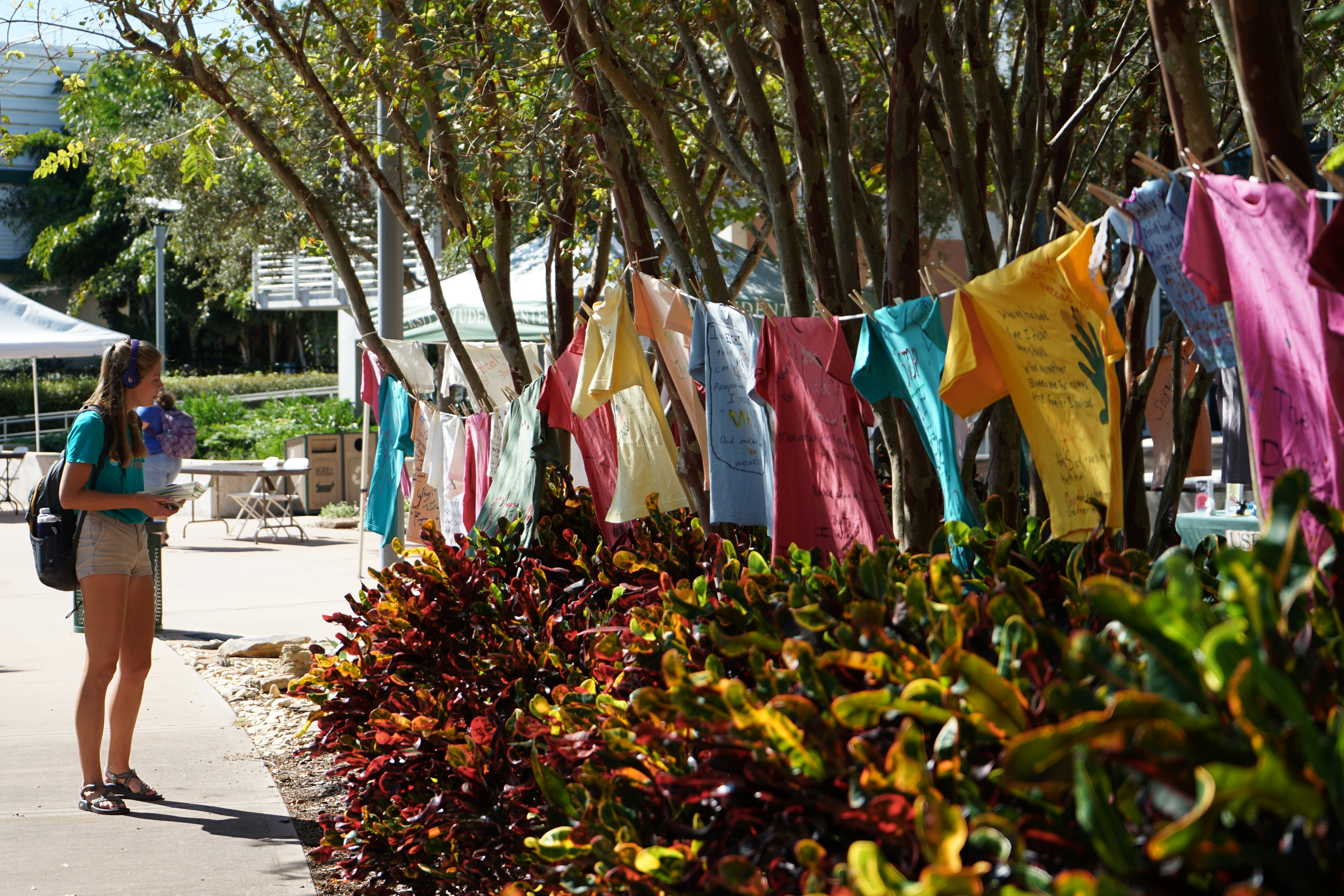
Patrick Tobin | The Crow’s Nest
By Seth Payan
The words “When you learn to hide the pain, you lose yourself” in black contrasted the bright green T-shirt they were painted on.
A vibrant array of other colorful shirts surrounded it, each one featuring a similar emotional statement that seemed to leave onlookers feeling empathetic, shocked, disturbed or all of the above.
“Airing your dirty laundry” can often be difficult and embarrassing, but the survivors of domestic and sexual abuse from Community Action Stops Abuse (CASA) support groups embraced this, hanging their thoughts and emotions out for everyone to see.
On Oct. 31, the Wellness Center at USF St. Petersburg hosted CASA and their own Clothesline Project on Harborwalk from 10 a.m. to 4 p.m.
Jessica Dickerson, a prevention advocate for CASA, and Nicole Puia, a volunteer, sat nearby on Harborwalk. They provided information to onlookers who took interest in the event, or listened to them share their personal connections to what they saw.
“I was working with some of the survivors that were creating the last couple of shirts yesterday, and it was a very powerful experience watching them,” Dickerson said. “You watch them go through the process of thinking what they wanted to say before putting it on the shirt. They felt empowered to have a platform and an outlet for their voices to be heard.”
The original Clothesline Project dates back to 1990, when shirts were hung in Hyannis, Massachusetts, to act as witness to the tens of thousands of domestic abuse survivors.
The clotheslines on both sides of Harborwalk displayed numerous colorful T-shirts that drew the attention of passersby. But it wasn’t the vibrant colors that caused people to stop and stare; it was the messages they shared.
All of them spilled tales and quotes from each survivor, recreating the emotions from their struggles with domestic and sexual abuse.
The colors served a purpose beyond attracting eyes.
White shirts represented women who died from the violence they endured. Yellow shirts told the stories of battered or assaulted women. Red, pink and orange shirts contained the stories of rape and sexual assault survivors.
Blue and green shirts represented survivors of incest. Purple shirts told the stories of women attacked because of their sexual orientation. Lastly, black shirts represented women who were attacked for political reasons.
“With this event, we hope to inspire people to realize that they’re not alone,” Dickerson said. “We want to inspire survivors and victims who don’t even know what they’re surviving right now so that they see some of their own experiences on these pieces of clothing and recognize that they need to reach out for support.”
Dickerson elaborated on CASA’s new “#CallItWhatItIs” campaign, which focuses on pressuring the media and community members to “call out domestic violence by its name to put a spotlight on this public health epidemic,” according to CASA’s website.
“We’ve identified news articles that report homicide due to domestic abuse — about 11 in Pinellas county last year — and only four of them used the word ‘abuse’,” Dickerson said. “There are many other examples of this happening in the media, and we encourage the community to see the research we’ve done on our website.”
Puia is a relatively new volunteer with CASA and is working on becoming a shelter advocate in hopes to work one-on-one with survivors.
“When I found out about CASA, I was just looking at volunteer organizations online,” Puia said. “I noticed the thrift store before, but I didn’t know about the actual organization… Since being around them, I’ve been surprised by the amount of services they offer, and I love seeing how dedicated they all are to their purpose.”
Dickerson reflected on her work with CASA, but one of the most memorable is still her first participant.
“She approached me, barely knowing any English, and told me about her abusive husband that brought her to the United States. He married her to bring her to the country and would later use that immigration fact as control,” she said. “She eventually became pregnant, using that as one more reason to fight for her life against the physical and sexual abuse.”
According to Dickerson, the woman escaped and began searching for agencies and shelters that would provide help — to little avail.
“She would frequently just be pushed along towards someone else, with no one looking to help her in her current state,” Dickerson said. “She told me, when she eventually got to me, that if she pushed along to someone else one more time, she wouldn’t have the strength to continue.
“This cause was still very new to me, like I said she was my first participant, so I felt the pressure. But I helped her, and I handled it creatively to make sure she received the resources and guidance that she needed. In that moment, I realized that this kind of work fulfilled me. She went on to go through our entire program, had her baby, found a place to live, and had her happy ending.
Dickerson said she received an email from the woman later detailing her “new life.”
“She told me, ‘Now every smile on my child’s face is yours,’” Dickerson said.



